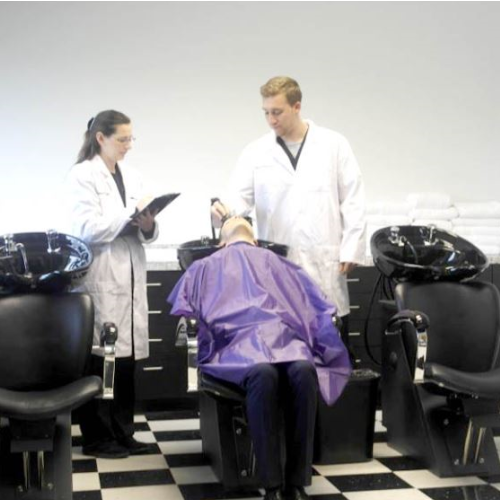Nalini KAUL – Vice President Technical Services
Consumers are constantly searching for new products and improved ways to achieve optimal hair health. They canvas drugstores and salons for products that will help create beautiful, healthy, shiny, and strong hair. Particularly in late summer and fall, when there is an increase in hair shedding, consumers turn to anti-hair loss products which promote hair growth and thickness. Every store shelf is like a conga-line of products claiming to help with everyday hair issues. The timeless question returns: which one should they pick?
Experts have consistently recognized that a healthy scalp is the key to maintaining healthy hair. Most scalp and hair products are bought as a result of professional recommendation or claims made on packaging. Substantiation of these claims is critical to safeguarding your brand’s integrity and to ensure you’re ready when a possible litigation lands at your doorstep.
The hair experts at PCR have one of the largest teams of haircare professionals in the industry that have worked on providing claim support for over 20 years. With four full services hair salons located across the world, we are best placed to help you with your claims. We have a database of subjects with diverse ethnicity that reaches every type of hair possible.
Hair evaluations are routinely offered for assessment of hair density, thickness, moisture, frizz control, static, hair manageability, combing forces, hair shine, hair volume, hair breakage, hair softness, hair suppleness, hair color, curl effect, curl retention, gloss, hair anti-loss/growth and hair photo protection. Scalp evaluations offered include dryness/flaking, hydration, irritation, inflammation, erythema, pruritus, oiliness, fatty acids, cytokine levels, overall scalp analyses with in vivo digital photography/microscopy.
PCR is an expert in designing study specific protocols that meet the need of the client and the claim. Our staff work with our hair stylists and scientists employing best methods and our recruitment team finds the right hair types.
Hair loss, alopecia, is caused by an imbalance of the hair growth cycle resulting from various factors, including metabolism, genetics, stress, nutritional, medical and environmental.
These factors lead to a reduced number of growing (anagen) hairs combined with an increased number of degenerating (telogen) hairs. Hair loss affects both women and men, albeit differently. Women experience diffuse hair loss and lose hair from the top of the head, while men hair’s loss can involve a substantial area, affecting the top of the head and the temporal area.
A clinical study to test an anti-hair loss or hair-growth product is designed for 3-6 months on volunteers with mild to moderate hair loss. Methodologies for evaluation loss include non-invasive techniques:
- hair counts,
- pull tests,
- pluck tests,
- standardized wash test,
- photographs,
- dermoscopy,
- hair weight,
- phototrichogram,
- trichoscan,
- electron microscopy and
and invasive techniques, such as a scalp biopsy. Effects studied include decrease of the telogen hair density, increase of the anagen hair density, increase of the growth coefficient (A/T) ratio at baseline, midpoint and at end of treatment phase.
For hair replenishment products, trained evaluators assess the subjects’ hair for attributes of shine, volume, thickness, softness, and general appearance/condition at baseline and after 8 to 12 weeks approximately. The Brush Friction Count Method (BFCM) is employed, and intact and broken hair are each counted. Macro photographs are taken of an area on the head with thinning hair and assessed for hair growth and count at baseline and/or at midpoint and at end of treatment period. Also, self-evaluation by subjects for any perceived improvements of specific criteria can provide useful information about the product.
Dandruff and Scalp Seborrheic Dermatitis (SD) are scalp conditions both caused by a yeast called Malassezia and result in flaking, erythema, itching and inflammation. The study design involves visual grading for erythema and flaking, bio-instrumentation like squamometry, digital photos along with selfperception questionnaires. Recently, clients are asking for inclusion of scalp microbe because of fits influence on scalp health, and involvement in the pathophysiology of scalp-related disorders. As the scalp surface provides a distinct microenvironment studying:
- pH,
- sebum level,
- hydration,
- transepidermal water loss (TEWL),
- dandruff severity,
- as well as the dysbiosis in the cutaneous microbiome assumes great importance.
Thus, a systematic measurement of scalp clinical and physiological parameters along with the scalp microbiome and associated functional pathways can help reveal important information.
Lately PCR has had a surge in requests for testing efficacy of hair care regimens that include shampoo, conditioner, scalp & hair serums, and dietary supplements. Clinical testing at PCR can aid in the substantiation of claims including “stimulates hair growth”, “extends hair life cycle”, “restores hair vitality”, “for denser hair.” As the demand and options for hair and scalp grooming products is growing, PCR is constantly expanding knowledge and utilizing our experience to keep up with the evolving trends to help our customers with rational and well thought out strategies for testing their products.
Read the entire FOCUS#4: Click here
Business Contacts
Canada: Elsie Kohoot
Site Director: elsiekohoot@princetonconsumer.com
Winnipeg, Canada
U.K: Kirstie Maguire VP Operations
kirstiemaguire@princetonconsumer.com
Chelmsford & Manchester, United Kingdom
USA Lisa Long
Director, Business Development
lisalong@princetonconsumer.com
Florida, USA










 Follow us on Linkedin!
Follow us on Linkedin!
You must be logged in to post a comment.